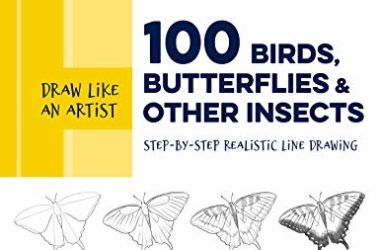Draw Like an Artist: 100 Birds, Butterflies, and Other Insects: Step-by-Step Realistic Line Drawing – A Sourcebook for Aspiring Artists and Designers (Volume 5) (Draw Like an Artist, 5)
Featuring more than 600 sketches depicting a vast array of beautiful winged forms, Draw Like an Artist: 100 Birds, Butterflies, and Other Insects is a must-have visual reference for student and aspiring artists, fantasy and scientific illustrators, urban sketchers—anyone who’s seeking to improve their realistic drawing skills.
This contemporary, step-by-step guidebook demonstrates fundamental art concepts like proportion, anatomy, and spatial relationships as you learn to draw a full range of winged creatures, all shown from a variety of perspectives. Each set of illustrations takes you from beginning sketch lines to a finished drawing. Author Melissa Washburn’s clear and elegant drawing stylewill make this a go-to sourcebook for years to come.
Learn how to:Establish basic shapes and symmetryArticulate lines for body shapes, wing forms, and shadingAdd defining detailsDraw Like an Artist: 100 Birds, Butterflies, and Other Insects is a library essential for any artist interested in learning how to draw the fascinating forms of birds and winged insects.
The books in the Draw Like an Artist series are richly visual references for learning how to draw classic subjects realistically through hundreds of step-by-step images created by expert artists and illustrators.
From the Publisher


HOW TO USE THIS BOOK
There are many tools, mediums, and styles in which to draw birds and insects. This book uses some techniques I’ve learned over the years and shows the methods I’ve found most useful for understanding the basics of drawing realistically. The figures and steps can be copied directly to achieve a finished drawing, and the processes and methods can be used for drawing many other subjects, whether plants, animals, or anything else.
Every subject in this book begins with solid shapes or directional lines to describe the general proportions of the subject. It’s important to establish the correct proportions in the first step. How large is the head relative to the body? What’s the general shape of the animal’s pose and main body sections? Next, gestural lines are added to show the position and proportions of features (eyes, beak, etc.), wings, and/or tail.
Blocking in the Figure






Step 1
Shows simple shapes to establish the placement of the head and body.
Step 2
Add some contour/shape to the neck as well as some gestural lines to find the placement of the eye, beak, wings, and tail.
Step 3
Shows the full contour of the wings and beak and the placement of the feet on the perch.


EXERCISE:
Using your favorite drawing tool, draw on a large piece of paper or chalkboard, and just practice getting smooth lines by drawing large, simple shapes. Create circles, ovals, or triangles in one long, large stroke moving from your shoulder. This is a good warm-up exercise before you begin drawing each day.
TIPS FOR BETTER LINE CONTROL TIP #1: DRAW WITH MORE THAN JUST YOUR HAND AND WRIST
Beginners tend to grip their pencil tightly and move just the hand/wrist. Practice loosening the grip on your pencil and moving your entire arm when you draw. You’ll find your lines become smoother and more consistent. Turn your paper if you need to, pulling down the page to create a smooth line. (It’s much easier to pull your lines down than to push them up.) Drawing large will also help.


Publisher : Quarry Books; Illustrated edition (November 3, 2020)
Language : English
Paperback : 112 pages
ISBN-10 : 163159947X
ISBN-13 : 978-1631599477
Item Weight : 2.31 pounds
Dimensions : 8.5 x 0.65 x 11 inches






































